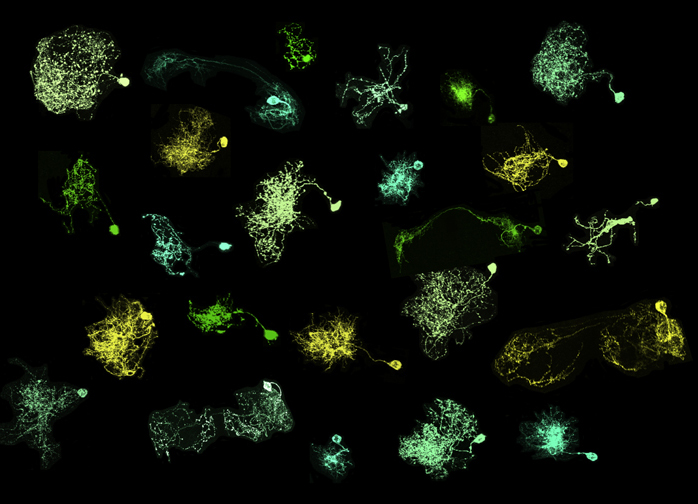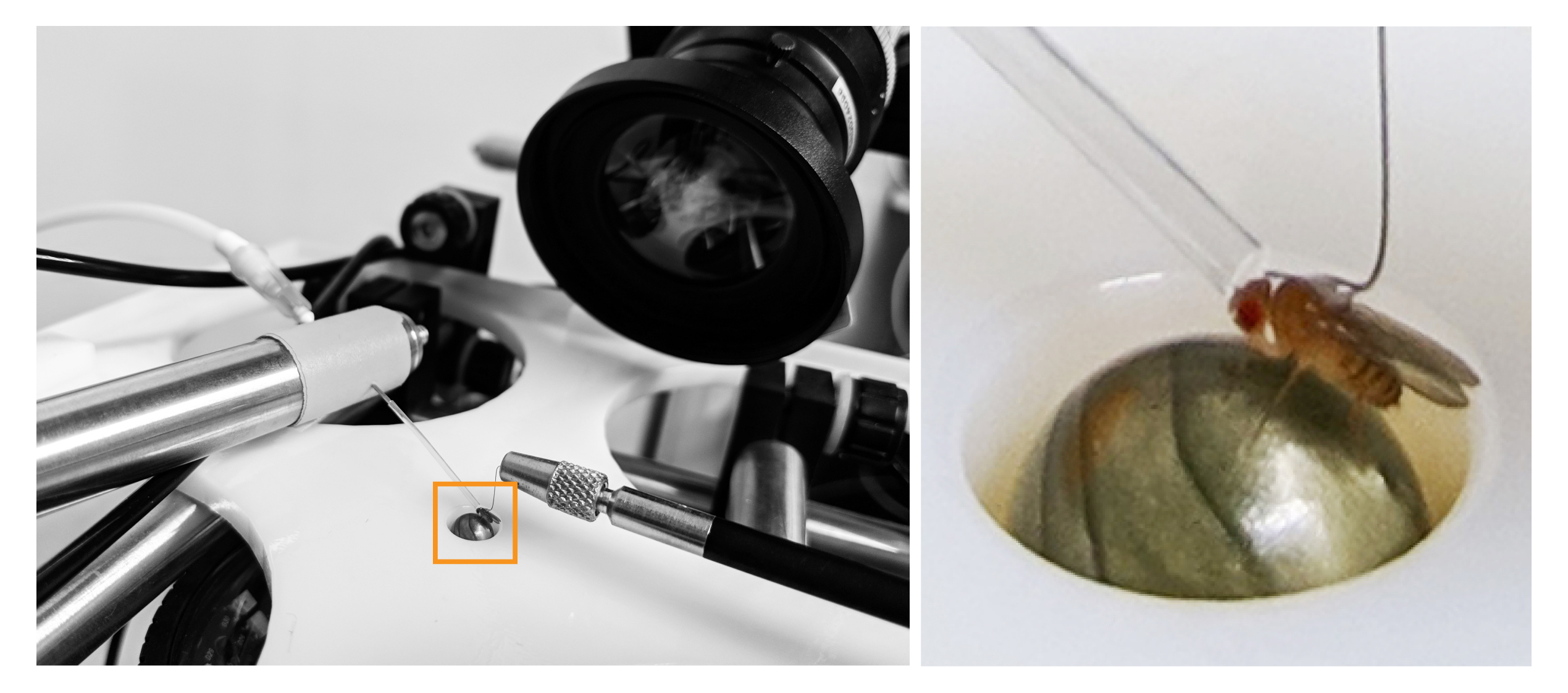Neural circuitry and behavior
-
- SpecialtyDevelopmental Neurobiology, Neuronal circuitry, Insect Behavior
- E-mailyhchou@gate.sinica.edu.tw
- Tel02-2789-9540
- LabR202/ICOB
Although sculpted by similar developmental programs, individuals in a given species exhibit great variation in their genetic composition and their behavioral patterns. Such innate variations could be further influenced by experience. How genetic, environmental, and experience-dependent factors collectively shape our brain circuits (thus individuality) is one of the central questions of biology. Our research attempts to understand how neuronal diversity and variability arise, how they contribute to neuronal circuit activity, dynamics and behavioral output, and how experience shapes the variability of the neuronal circuit. Specifically, we try to explore the underlying mechanisms involved in neuronal variability in the fruit fly olfactory system, with a particular focus on the development, organization, variation and function of the local interneuron network.
Development of loca interneuron diversity

For animals to respond properly to environmental stimuli, sensory information must be precisely relayed from peripheral neurons to central brain neurons. The fidelity of this information relay depends on the organization and precise connection of neurons within and between tiers of sensory processing circuits. In Drosophila olfactory system, olfactory local interneurons (LNs) form extensive synapses with sensory neurons, second-order neurons and other LNs in the antennal lobe (AL), and modulate odor information. LNs either innervate one AL or both ALs, and display extensive diversity and variability. We have built the developmental map of LNs (Fig. 1) and reagents to label several different types of LNs. Three unbiased forward genetic screens to search for molecules involved in the LN development and wiring were conducted. Currently we are exploring the development of distinct types of LNs and the underlying molecular mechanisms.
Local interneuron variability
One of the factors underlying the complexity of neuronal circuits is variation among individuals, which is a daunting challenge in mammals. The fact that Drosophila LNs exhibit variability across individuals offers an unprecedented opportunity to study the mechanisms that give rise to neuronal variability and the consequences of such variability on behavior. We recently demonstrated that a single identified LN, TC-LN, can exhibit as many as 849 distinct innervation patterns, which are the results of developmental noise, sexual dimorphism, age, and experience-induced plasticity. We are currently exploring the variability of distinct types of LNs with the reagents we built.
Modeling the function and dynamics of local interneuron network

With the powerful genetic tools we built, we can temporally label and manipulate single local interneurons. We are interested in testing if distinct types of LNs and their variability characterized above will have any consequences to the behavior. Specifically, we are using calcium imaging system, optogenetic systems, different self-built behavioral paradigms (Fig. 2), machine learning, and mathematical modeling to address whether LN innervation variability leads to any variation in circuit activity, dynamics, and behaviors.
- 2019 Editorial board, Journal of Neurogenetics
- 2016 Selected as eLife early-career reviewer
- 2015 EMBO Travel grant
- 2013 Career Development Award (Academia Sinica)
- 2012 Initial Employment Academic Research Grants (Academia Sinica)
- 2003 Chien-Tien Hsu Outstanding Graduate Dissertation Award (The Chinese Society of Cell and Molecular Biology)
- 2003 Outstanding Students Conference Travel Grant (Foundation for the Advancement of Outstanding Scholarship)
| Name | Job Title | Telephone | Remark | |
|---|---|---|---|---|
| Ya-Hui Chou | Associate Research Fellow | 02-27899540 | yhchou@gate.sinica.edu.tw | Aug. 2011 ~ |
| Hao-Hsin Chang | PhD student | 02-27899509 | s0170543@gate.sinica.edu.tw | Aug. 2016 ~ |
| Hsin-Ti Hsieh | PhD student | 02-27899509 | as0191334@gate.sinica.edu.tw | Aug. 2019 ~ |
| Gaurav Meena | Research Assistant | 02-27899509 | gaurav@gate.sinica.edu.tw | Jun. 2024 ~ |
| Chen-Tse Lu | Research Assistant | 02-27899509 | luchentse@gate.sinica.edu.tw | Oct. 2024 ~ |
| Cheng-Ching Hsieh | Research Assistant | 02-27899509 | -- | Feb. 2025 ~ |
| Ruo-Han Hsiao | Administration Assistant | 02-27899509 | ruohan1998@gate.sinica.edu.tw | Mar. 2025 ~ |
| Shing-Hsien Chou | Medical Doctor | 02-27899509 | b85401053@ntu.edu.tw | Apr. 2012 ~ |
| Ming-Yu Huang | Asistant | 02-27899509 | -- | May. 2024 ~ |
- 1
- Manoim-Wolkovitz, J.E., Camchy, T., Rozenfeld, E., Chang, H.H., Lerner, H., Chou, Y.H., Darshan, R., Parnas, M*. (2025) Nonlinear high-activity neuronal excitation enhances odor discrimination. Current Biology. 35, 1521-1538. DOI: 10.1016/j.cub.2025.02.034
- 2
- Tsai, K.T., Chou, Y.H.* (2022) Drosophila as a Model to Explore Individuality. In: Yamamoto, D. (eds) Behavioral Neurogenetics. Neuromethods, v181, 223-255. Humana, New York, NY. Springer Protocols. DOI: 10.1007/978-1-0716-2321-3_13
- 3
- Chou, Y.H.*, Yang, C.J., Huang, H.W., Liou, N.F., Panganiban, M.R., Luginbuhl, D., Yin, Y., Taisz, I., Liang, L., Jefferis, G.S.X.E., Luo, L. (2022) Mating-driven Variability in Olfactory Local Interneuron Wiring. Science Advances. 8, eabm7723. DOI: 10.1126/sciadv.abm7723
- 4
- Tsai, K.T., Chou, Y.H.* (2019) Random walk revisited: quantification and comparative analysis of Drosophila walking trajectories. iScience 19, 1145-1159. DOI: 10.1016/j.isci.2019.08.054.
- 5
- Tsai, K.T., Liou, N.F. and Chou, Y.H.* (2019). Quantitatively analyzing morphological phenotypes of neurons and neuropils through three-dimensional reconstruction of Drosophila brains. Bio-101. e1010290. DOI: 10.21769/BioProtoc.10101290. (in Chinese)
- 6
- Chang, H. H. and Chou, Y. H.* (2019). Labeling single cells by Mosaic analysis with a repressible maker (MARCM) in Drosophila nervous system. Bio-101. e1010289. DOI:10.21769/BioProtoc.10101289. (in Chinese)
- 7
- Yang, C.J., Tsai, K.T., Liou, N.F., Chou, Y.H.* (2019) Interneuron diversity: toward a better understanding of interneuron development in the olfactory system. J. Experimental Neuroscience. 13, 1-5. (Invited review). DOI:10.1177/1179069519826056
- 8
- Chen, Y.J.#, Chang, H.H.#, Lin, S.H.#, Lin, T.Y., Wu, T.H., Lin, H.J., Liou, N.F., Yang, C.J., Chen, Y.T., Chang, K.H., Li,C.Y., Chou, Y.H.* (2019) Differential efficacy of genetically swapping GAL4. J. Neurogenetics. 33, 52-63. DOI:10.1080/01677063.2018.1564289
- 9
-
Liou, N.F.#, Lin, S.H.#, Chen, Y.J.#, Tsai, K.T.&, Yang, C.J.&, Lin, T.Y., Wu, T.H., Lin, H.J., Chen, Y.T., Gohl, D.M., Silies, M., Chou, Y.H.* (2018) Diverse populations of local interneurons integrate into the Drosophila adult olfactory circuit. Nature Communications 9, 2232. DOI:10.1038/s41467-018-04675-x
Recommended by F1000Prime. Hiesinger P:F1000Prime, 10.3410 (Dec. 2018) 10.3410/f.733424303.793554440
- 10
- Tsai, K.T., Hu, C.K., Li, K.W., Hwang, W.L., Chou, Y.H.* (2018) Circuit variability interacts with excitatory-inhibitory diversity of interneurons to regulate network encoding capacity. Scientific Reports 8, 8027. DOI:10.1038/s41598-018-26286-8
- 11
- Hsia, E.Y.C., Zhang, Y., Tran, H.S., Lim, A., Chou, Y.H., Lan, G., Beachy, P.A., Zheng, X. (2017) Hedgehog mediate degradation of Ihog adhesion peoteins modulates cell segragation in Drosophila wing imaginal discs. Nature Communications 8, 1275. DOI:10.1038/s41467-017-01364-z
- 12
- Wu, B., Li J., Chou, Y.H., Luginbuhl D., and Luo L. (2017) Fibroblast growth factor signaling instructs ensheathing glia warpping of Drosophila olfactory glomeruli. Proceedings of the National Academy of Sciences USA 114, 7505-7512. DOI:10.1073/pnas.1706533114
- 13
- Sweeney, L.B., Chou, Y.H.#, Wu, Z.#, Joo W.#, Komiyama, T., Potter, C.J., Kolodkin, A., Garcia, K.C., and Luo, L. (2011) Secreted Semaphorins from degenerating larval ORN axons direct adult projection neuron dendrite targeting. Neuron 72, 734-747. DOI:10.1016/j.neuron.2011.09.026
# equal authorship
- 14
- Chou, Y.H., Zheng, X., Beachy, P.A. and Luo, L. (2010) Patterning axon targeting of olfactory receptor neurons by coupled Hedgehog signaling at two distinct steps. Cell 142, 954-966. DOI:10.1016/j.cell.2010.08.015
Featured in Nat. Rev. Neurosci, Research Highlights. (Nov. 2010) DOI:10.1038/nrn2940
- 15
- Chou, Y.H.#, Spletter, M.L.#, Yaksi, E.#, Leong, J.C.S., Wilson, R.I. and Luo, L. (2010) Diversity and wiring variability of olfactory local interneurons in the Drosophila antennal lobe. Nature Neuroscience 13, 439-449. DOI:10.1038/nn.2489
# equal authorshipFeatured on the cover
- 16
- Sweeney, L.B., Couto, A.#, Chou, Y.H.#, Berdnik, D., Dickson, B.J., Luo, L., and Komiyama, T. (2007). Temporal target restriction of olfactory receptor neurons by Semaphorin-1a/PlexinA-mediated axon-axon interactions. Neuron 53, 185-200. DOI:10.1016/j.neuron.2006.12.022
# equal authorshipPreview by Greg J. Bashaw DOI:10.1016/j.neuron.2007.01.002
- 17
- Chou, Y.H. and Chien, C.T. (2002). Scabrous controls ommatidial rotation in the Drosophila compound eye. Developmental Cell 3, 839-850. https://doi.org/10.1016/S1534-5807(02)00362-3
- 18
- Hsu, S.L., Chen, M.C., Chou, Y.H., Hwang, G.Y., and Yin, S.C. (1999). Induction of P21CIP1/Waf1 and activation of p34cdc2 involved in retinoic acid-induced apoptosis in human hepatoma Hep3B cells. Experimental Cell Resesrach 248, 87-96. DOI:10.1006/excr.1999.4397
- 19
- Hsu, S.L.*, Chou, Y.H., Yin, S.C., and Liu, J.Y. (1998). Differential effects of phorbol ester on growth and protein kinase C isoenzyme regulation in human hepatoma Hep3B cells. Biochemical Journal 333, 57-64. DOI: 10.1042/bj3330057.
- 20
- Chou, Y.H. and Yung, B.Y. M.* (1995). Cell cycle phase-dependent changes of localization and oligomerization states of nucleophosmin/B23. Biochemical and Biophysical Research Communications 217, 313-325. DOI: 10.1006/bbrc.1995.2779.